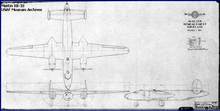Martin XB-33 Super Marauder Video - Picture

|
|
Martin XB-33 Super Marauder
XB-33 Super Marauder
National origin: United States
Manufacturer: Glenn L. Martin Company
Status: Cancelled 25 November 1942
Primary user: United States Army Air Forces
Number built: None
Developed from: B-26 Marauder
The Martin B-33 was designed by the Glenn L. Martin Company as the Martin Model 190 and was a high-altitude derivative of the company's B-26 Marauder. Two different designs were developed, first as a twin-engined aircraft and then as a four-engined aircraft. The four-engined version was ordered by the United States Army Air Forces but the program was cancelled before any aircraft were built.
Design and development
XB-33

Picture - Schematic blueprint drawing of the XB-33.
The first version of the B-33 design, the XB-33, was a twin-tailed medium bomber with two Wright R-3350 engines and pressurised crew compartments; its design began in 1940. It would carry around 4,000 lb (1,814 kg) of bombs. Soon after design of the XB-33 began it became clear that a twin-engined aircraft would not achieve the performance requested by the army. The company moved on to developing a larger four-engined design and the two prototypes ordered by the USAAF were not built.
XB-33A
Following the abandoment of the original twin-engined design the company continued to design a larger four-engined design and two prototypes were ordered by the USAAF as the XB-33A; its bombload was to have been 12,000 lb (5,443 kg), as much as that of the B-24 Liberator, the heaviest US bomber flown in combat prior to the B-29.
The original XB-33 design was to be powered by the R-3350, the redesigned XB-33A was to use Wright R-2600 engines. The main reason for this was demand for R-3350s for the B-29, one of the most highly valued projects of the Army Air Forces.
On January 17, 1942, the USAAF placed an order for 400 B-33As to be built at the government-owned plant in Omaha, Nebraska operated by Martin. On November 25, 1942 the project was cancelled to allow the Omaha plant to concentrate on manufacturing B-29s.
Variants
XB-33
Prototype medium bomber powered by two 1,800 hp (1,343 kW) R-3350 engines, two cancelled.
XB-33A
Prototype medium bomber powered by four 1,800 hp (1,343 kW) R-2600-15 engines, two cancelled.
B-33A Super Marauder
Production variant of XB-33A, 400 on order cancelled.
Specifications (B-33A, as designed)
General characteristics
Crew: 7
Length: 79 ft 10 in (24.3 m)
Wingspan: 134 ft (40.8 m)
Height: 24 ft (7.32 m)
Wing area: 1,646 ft² (153 m²)
Empty weight: 85,000 lb (39,000 kg)
Loaded weight: 95,000 lb (43,000 kg)
Powerplant: 4x— Wright R-2600-15 radial engines, 1,800 hp (1,300 kW each) each
Performance (estimated)
Maximum speed: 345 mph (300 kn, 555 km/h)
Cruise speed: 242 mph (210 kn, 389 km/h)
Range: 2,000 mi (1,700 nmi, 3,000 km)
Service ceiling: 39,000 ft (12,000 m)
Rate of climb: ft/min (m/s)
Wing loading: 58 lb/ft² (280 kg/m²)
Power/mass: 0.076 hp/lb (55 W/kg)
Armament
Guns: 8x— .50 in (12.7 mm) machine guns
Bombs: 10,000 lb (4,500 kg)
Related development
B-26 Marauder
Encyclopedia of American Aircraft
Andrade, John (1979). U.S.Military Aircraft Designations and Serials since 1909. Midland Counties Publications. ISBN ISBN 0 904597 22 9.
Martin XB-33 Super Marauder Pictures and Martin XB-33 Super Marauder for Sale.
Living Warbirds: The best warbirds DVD series.
Source: WikiPedia